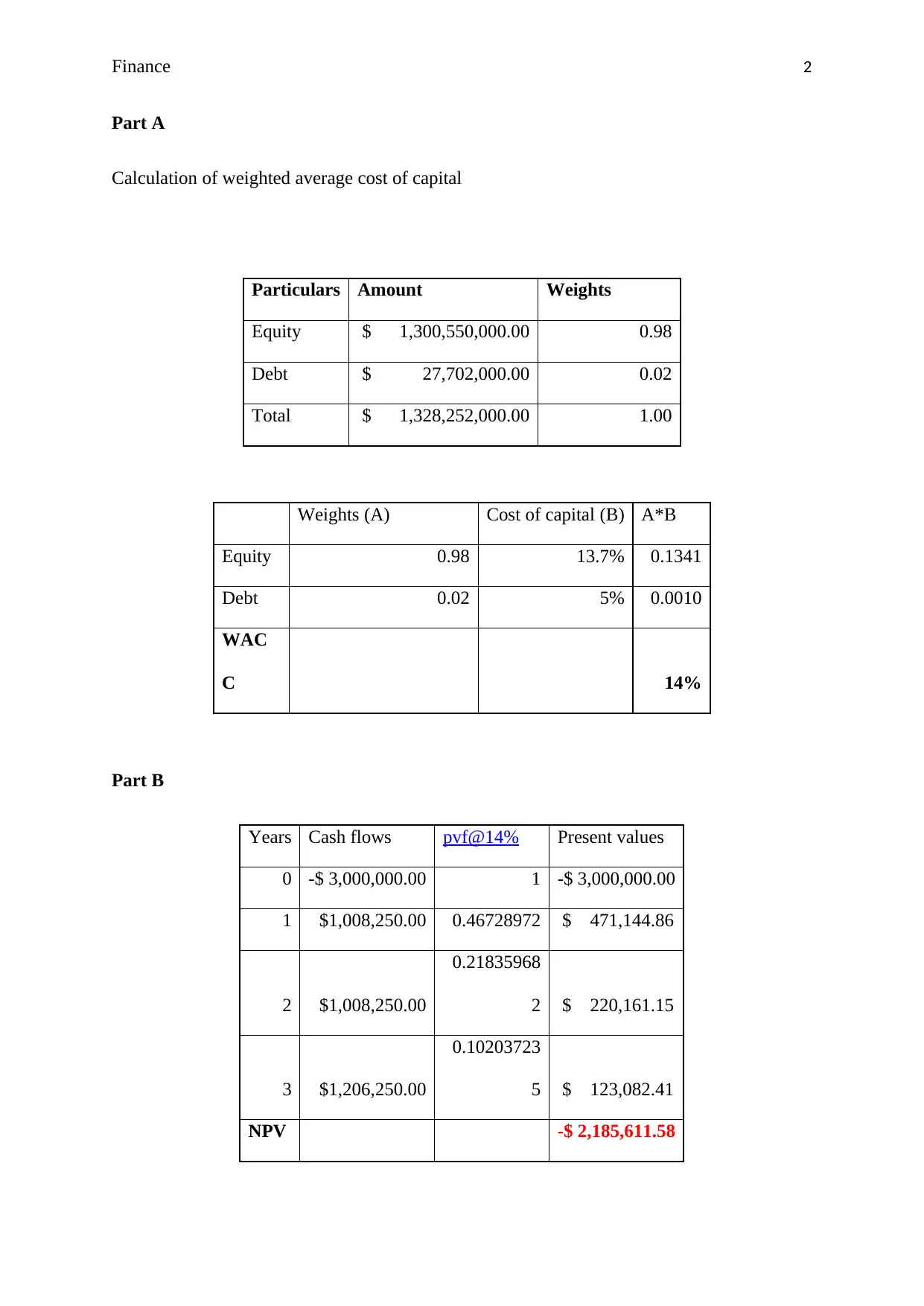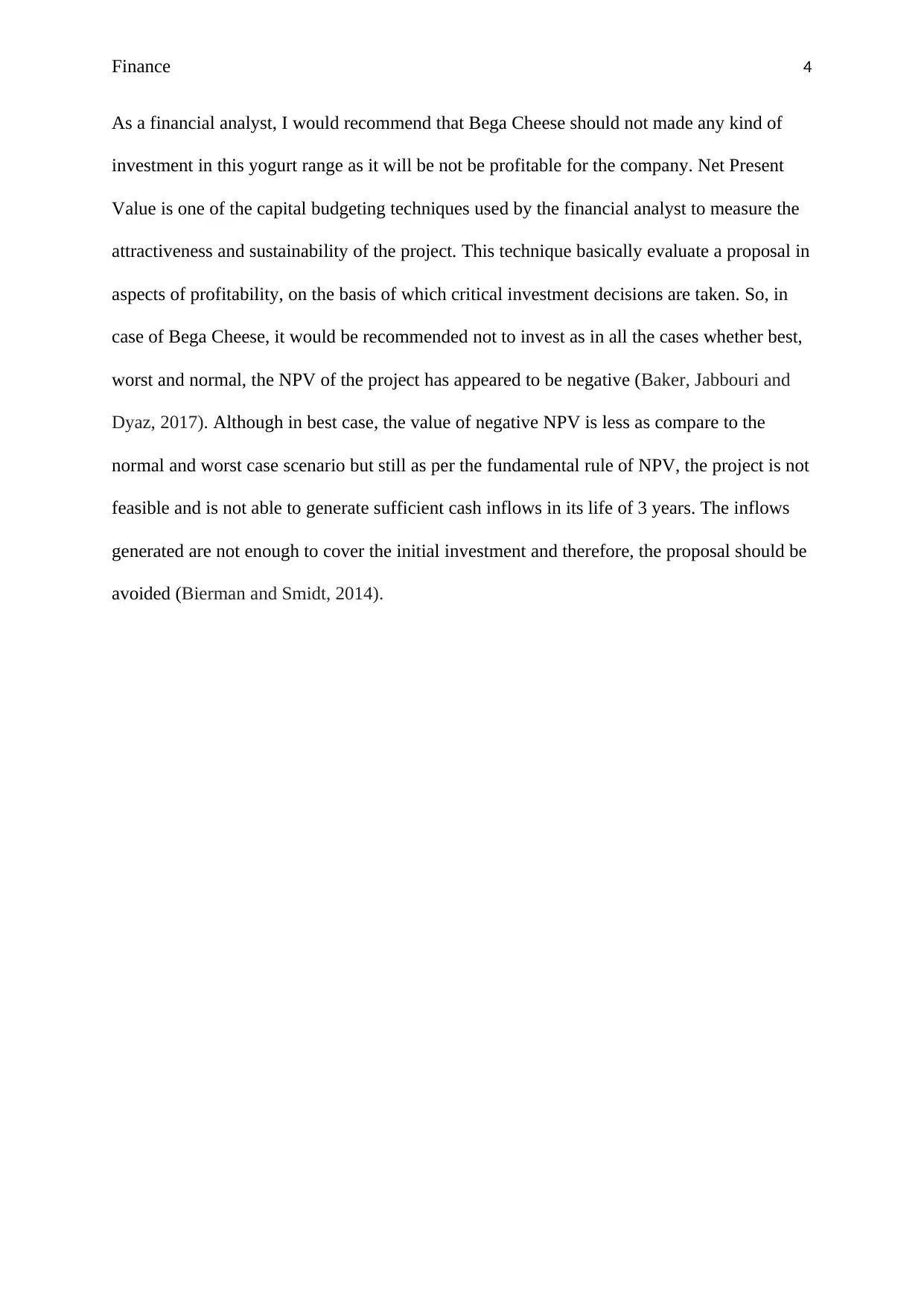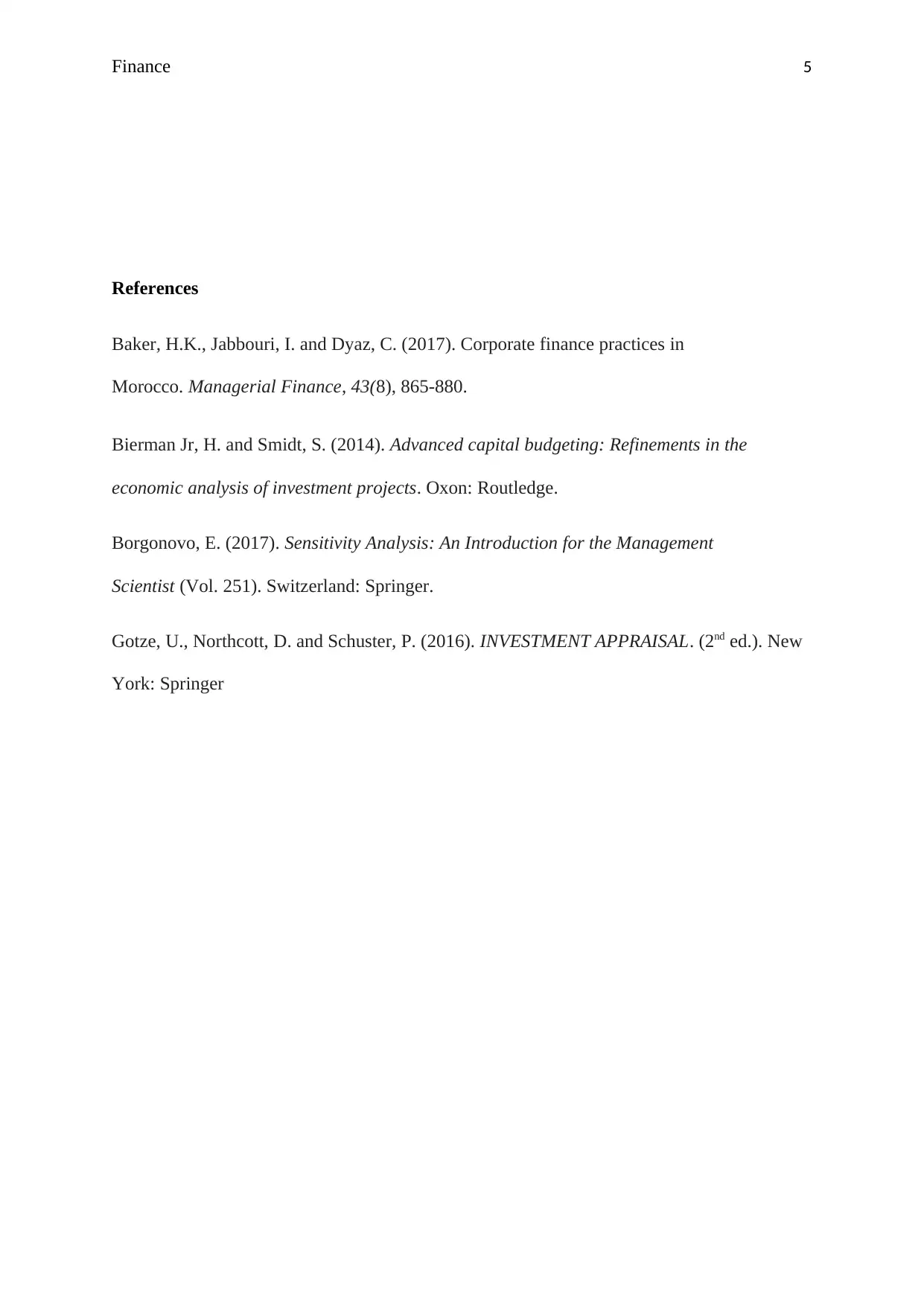BAP53 Corporate Finance: Capital Budgeting & Bega Cheese Analysis
VerifiedAdded on 2023/06/10
|5
|739
|385
Case Study
AI Summary
This case study assesses whether Bega Cheese should invest in a new yogurt range using Net Present Value (NPV) analysis. The solution calculates the Weighted Average Cost of Capital (WACC) and evaluates the project's NPV under normal, best-case, and worst-case scenarios. The analysis revea...

RUNNING HEAD: FINANCE
Corporate Finance
Corporate Finance
Paraphrase This Document
Need a fresh take? Get an instant paraphrase of this document with our AI Paraphraser

Finance 2
Part A
Calculation of weighted average cost of capital
Particulars Amount Weights
Equity $ 1,300,550,000.00 0.98
Debt $ 27,702,000.00 0.02
Total $ 1,328,252,000.00 1.00
Weights (A) Cost of capital (B) A*B
Equity 0.98 13.7% 0.1341
Debt 0.02 5% 0.0010
WAC
C 14%
Part B
Years Cash flows pvf@14% Present values
0 -$ 3,000,000.00 1 -$ 3,000,000.00
1 $1,008,250.00 0.46728972 $ 471,144.86
2 $1,008,250.00
0.21835968
2 $ 220,161.15
3 $1,206,250.00
0.10203723
5 $ 123,082.41
NPV -$ 2,185,611.58
Part A
Calculation of weighted average cost of capital
Particulars Amount Weights
Equity $ 1,300,550,000.00 0.98
Debt $ 27,702,000.00 0.02
Total $ 1,328,252,000.00 1.00
Weights (A) Cost of capital (B) A*B
Equity 0.98 13.7% 0.1341
Debt 0.02 5% 0.0010
WAC
C 14%
Part B
Years Cash flows pvf@14% Present values
0 -$ 3,000,000.00 1 -$ 3,000,000.00
1 $1,008,250.00 0.46728972 $ 471,144.86
2 $1,008,250.00
0.21835968
2 $ 220,161.15
3 $1,206,250.00
0.10203723
5 $ 123,082.41
NPV -$ 2,185,611.58

Finance 3
The Net present value of the project is negative with -$2,185,611.58 and as per the
fundamental rule of NPV, the management must not go ahead with the project. NPV is
basically a profitability indicator of the project. It is a method used to by the companies and
investors to know about the feasibility and viability of a proposal. The method takes into
account time value of money and considers the present value of cash flows. As per the rule, a
negative NPV means that the cash outflow of the project is more than the cash inflow. In
other words, it state that the project is not capable enough to generate enough cash inflows to
cover its initial outlay (Gotze, Northcott and Schuster, 2016). Hence, management should
reject the project.
Part C
Value of NPV in the three cases:
Normal scenario Best scenario Worst Scenario
-$ 2,185,611.58
-$
1,516,274.86 -$ 2,323,377.97
As it is clear that, in normal situations the NPV of the project is negative but when performed
a sensitivity analysis, best and worst case scenarios are analysed. In best case scenario, the
NPV of the project is also negative but less than the normal case. The outflow is less because
of the increase in number of units and the variable cost per units has reduced. In worst case
scenario the NPV become -$ 2,323,377.97 where the output is less produced and the cost has
increased. So, basically the management must not go for any of the cases as NPV is negative
in both of them. Moreover, it is pretty much clear that this project will not make profits in
future (Borgonovo, 2017).
Part D
The Net present value of the project is negative with -$2,185,611.58 and as per the
fundamental rule of NPV, the management must not go ahead with the project. NPV is
basically a profitability indicator of the project. It is a method used to by the companies and
investors to know about the feasibility and viability of a proposal. The method takes into
account time value of money and considers the present value of cash flows. As per the rule, a
negative NPV means that the cash outflow of the project is more than the cash inflow. In
other words, it state that the project is not capable enough to generate enough cash inflows to
cover its initial outlay (Gotze, Northcott and Schuster, 2016). Hence, management should
reject the project.
Part C
Value of NPV in the three cases:
Normal scenario Best scenario Worst Scenario
-$ 2,185,611.58
-$
1,516,274.86 -$ 2,323,377.97
As it is clear that, in normal situations the NPV of the project is negative but when performed
a sensitivity analysis, best and worst case scenarios are analysed. In best case scenario, the
NPV of the project is also negative but less than the normal case. The outflow is less because
of the increase in number of units and the variable cost per units has reduced. In worst case
scenario the NPV become -$ 2,323,377.97 where the output is less produced and the cost has
increased. So, basically the management must not go for any of the cases as NPV is negative
in both of them. Moreover, it is pretty much clear that this project will not make profits in
future (Borgonovo, 2017).
Part D
⊘ This is a preview!⊘
Do you want full access?
Subscribe today to unlock all pages.

Trusted by 1+ million students worldwide

Finance 4
As a financial analyst, I would recommend that Bega Cheese should not made any kind of
investment in this yogurt range as it will be not be profitable for the company. Net Present
Value is one of the capital budgeting techniques used by the financial analyst to measure the
attractiveness and sustainability of the project. This technique basically evaluate a proposal in
aspects of profitability, on the basis of which critical investment decisions are taken. So, in
case of Bega Cheese, it would be recommended not to invest as in all the cases whether best,
worst and normal, the NPV of the project has appeared to be negative (Baker, Jabbouri and
Dyaz, 2017). Although in best case, the value of negative NPV is less as compare to the
normal and worst case scenario but still as per the fundamental rule of NPV, the project is not
feasible and is not able to generate sufficient cash inflows in its life of 3 years. The inflows
generated are not enough to cover the initial investment and therefore, the proposal should be
avoided (Bierman and Smidt, 2014).
As a financial analyst, I would recommend that Bega Cheese should not made any kind of
investment in this yogurt range as it will be not be profitable for the company. Net Present
Value is one of the capital budgeting techniques used by the financial analyst to measure the
attractiveness and sustainability of the project. This technique basically evaluate a proposal in
aspects of profitability, on the basis of which critical investment decisions are taken. So, in
case of Bega Cheese, it would be recommended not to invest as in all the cases whether best,
worst and normal, the NPV of the project has appeared to be negative (Baker, Jabbouri and
Dyaz, 2017). Although in best case, the value of negative NPV is less as compare to the
normal and worst case scenario but still as per the fundamental rule of NPV, the project is not
feasible and is not able to generate sufficient cash inflows in its life of 3 years. The inflows
generated are not enough to cover the initial investment and therefore, the proposal should be
avoided (Bierman and Smidt, 2014).
Paraphrase This Document
Need a fresh take? Get an instant paraphrase of this document with our AI Paraphraser

Finance 5
References
Baker, H.K., Jabbouri, I. and Dyaz, C. (2017). Corporate finance practices in
Morocco. Managerial Finance, 43(8), 865-880.
Bierman Jr, H. and Smidt, S. (2014). Advanced capital budgeting: Refinements in the
economic analysis of investment projects. Oxon: Routledge.
Borgonovo, E. (2017). Sensitivity Analysis: An Introduction for the Management
Scientist (Vol. 251). Switzerland: Springer.
Gotze, U., Northcott, D. and Schuster, P. (2016). INVESTMENT APPRAISAL. (2nd ed.). New
York: Springer
References
Baker, H.K., Jabbouri, I. and Dyaz, C. (2017). Corporate finance practices in
Morocco. Managerial Finance, 43(8), 865-880.
Bierman Jr, H. and Smidt, S. (2014). Advanced capital budgeting: Refinements in the
economic analysis of investment projects. Oxon: Routledge.
Borgonovo, E. (2017). Sensitivity Analysis: An Introduction for the Management
Scientist (Vol. 251). Switzerland: Springer.
Gotze, U., Northcott, D. and Schuster, P. (2016). INVESTMENT APPRAISAL. (2nd ed.). New
York: Springer
1 out of 5
Related Documents
Your All-in-One AI-Powered Toolkit for Academic Success.
+13062052269
info@desklib.com
Available 24*7 on WhatsApp / Email
![[object Object]](/_next/static/media/star-bottom.7253800d.svg)
Unlock your academic potential
© 2024 | Zucol Services PVT LTD | All rights reserved.



